El Banco de Oaxaca
An earlier attempt
On 8 April 1892 the federal executive agreed a contract[text needed] with Samuel Lederer to establish a bank of issue in the state of Oaxaca. However, Lederer was unable to fulfil the conditions of the contract and it was finally declared void in the bonfire of unfulfilled concessions that Limantour made in March 1897 to clear the way for his Ley General de Instituciones de Crédito.
El Banco de Oaxaca
This bank grew out of the branch of the Banco Oriental de México that it had opened in Oaxaca in July 1901The junta de vigilancia was composed of Jacobo L. Grandison, José Zorrilla and Francisco Gómez Trápaga, the manager was Guillermo Trinker and the book-keeper (tenedor de libros) Luis Benitez (El Popular, 8 July 1901) and the close ties of the founders (five from Puebla, almost all Spaniards and three from Oaxaca, again with Spanish roots apart from the Scotsman Jacobo Lucas Grandison). The concession for the bank was granted on 17 July 1902 to Quijano y RiveroQuijano y Rivero y Compañía, formed in 1900 to establish the La Esperanza cotton textile factory, was, in fact, a partnership of partnerships: the 'socios' were the original Jose Antonio Quijano and Manuel Rivero Collada partnership of Puebla, the Mowatt y Grandison Hijos partnership of Oaxaca, and Francisco M. Conde. They invested $53,000 in the venture. Within six years, that investment had leveraged $429,731 in net borrowing, which financed the purchase of assets valued at $508,741 .37. Nevertheless, the business was not successful, and in 1906 the partnership dissolved after four years of losses. Ownership of the La Esperanza factory passed to Quijano and Rivero, who now owed the other two partners $52,674. Rather than sell off ten per cent of the firm's assets to pay off their partners, they financed their takeover through paper discounted at the Banco Oriental de México, of which Rivero was president. They then re-equipped the factory, and it achieved profitability Had they lacked recourse to the Banco Oriental de México, it is likely that the factory would have been broken up upon the partnership's dissolution in 1906. , the succesors to José Zorrilla y Ca., and Manuel Rivero Collada, representing Trápaga y Ca, and Mowatt y Grandison, hijos.
| Number of shares |
Percentage of total |
|
| From Puebla | ||
| Manuel Rivero Collada | 1,200 | 24 |
| José Antonio Quijano | 200 | 4 |
| Agustín de la Hidalga | 200 | 4 |
| Angel Díaz Rubín | 200 | 4 |
| Andrés Lastra | 200 | 4 |
| From Oaxaca | ||
| José Zorrilla Tejada | 1,200 | 24 |
| Jacobo Lucas Grandison | 200 | 4 |
| Francisco Gómez Trápaga | 200 | 4 |
| Sucesores de José Zorrilla | 200 | 4 |
| Mowatt Grandison Hijos | 200 | 4 |
| Other shareholders from Puebla | 2,000 | 40 |
Founding shareholders
The new bank operated from 15 November 1902. Though autonomous, it continued to function as a branch, with the same manager, premises (at 1a calle Armenta y López), account holders and using the Banco Oriental de México notes until their own were delivered.
Branch offices were opened in Ocotlán, Puerto Angel, Salina Cruz, Tehuantepec (Istmo)a small city but with future promise. The branch opened on 31 July 1905 with Francisco Guzmán as manager and Rafael Silva as cajero-contador. Silva was replaced at the start of 1907 by Carlos Trinker, Guillermo’s son and Tuxtepec.
The bank could not survive the financial crisis of 1908 and it was absorbed by the Banco Oriental de México, of Puebla, on 21 June 1909A detailed history of the origins and fortunes of the bank can be found in "De dependencia e insolvencia: el Banco de Oaxaca, 1902-1909" by Leticia Gamboa Ojeda, in Historia Mexicana, vol. LVI, núm. 2, 2006, pp. 471-531.
American Bank Note Company print runs
The American Bank Note Company produced the following notes. It engraved the vignette of the Juárez statue (C 863) for the $5, $50 and $100 notes and of a Tehuantepec girl (C 872) for all the reverses.
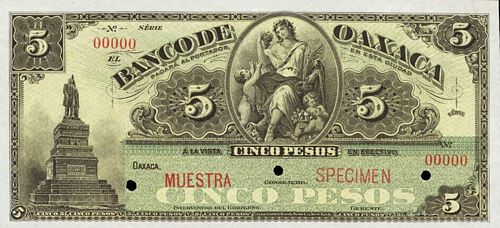
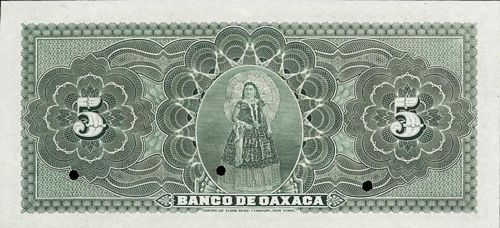
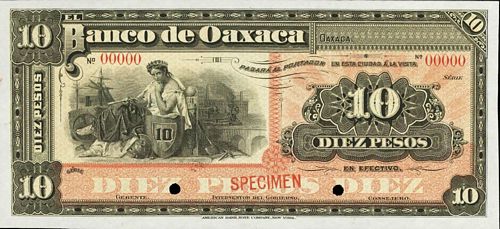
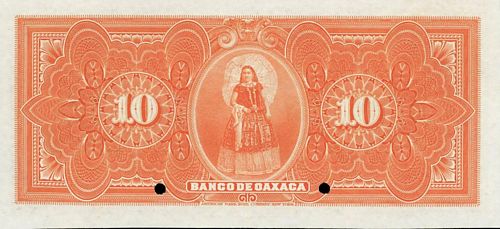
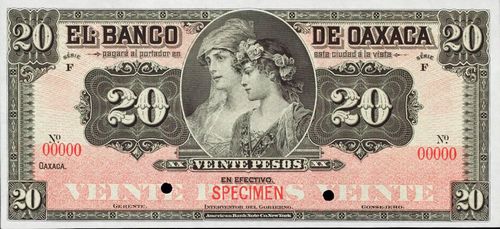
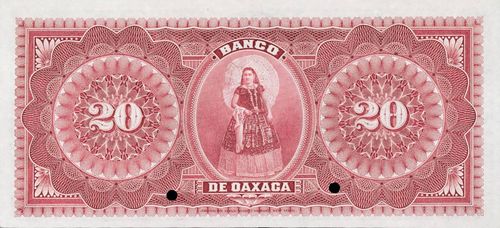
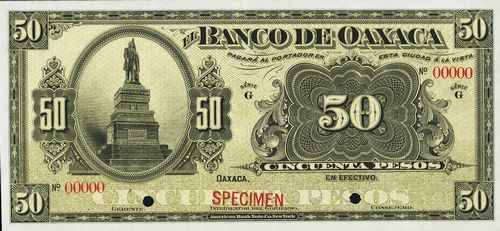
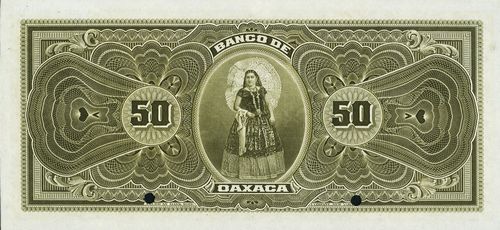
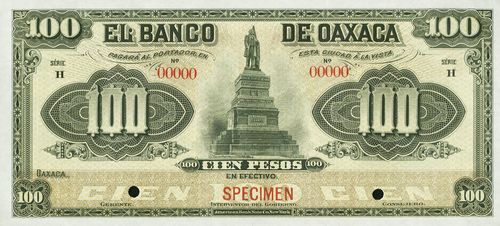
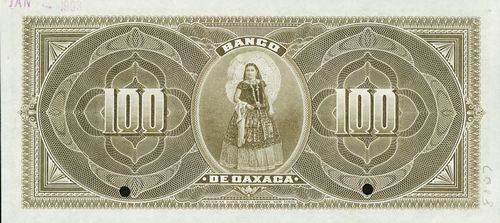
| Date | Value | Number | Series | from | to |
| September 1902 | $5 | 80,000 | A | 1 | 10000 |
| B | 10001 | 20000 | |||
| C | 20001 | 30000 | |||
| D | 30001 | 40000 | |||
| A | 57751 | 67750 | |||
| B | 67751 | 77750 | |||
| C | 77751 | 87750 | |||
| D | 87751 | 97750 | |||
| $10 | 25,000 | E | 40001 | 52500 | |
| E | 97751 | 110250 | |||
| $20 | 7,500 | F | 52501 | 56250 | |
| F | 110251 | 114000 | |||
| $50 |
2,000 | G | 56251 | 57250 | |
| G | 114001 | 115000 | |||
| $100 |
1,000 | H | 57251 | 57750 | |
| H | 115001 | 115500 |
On 18 October 1906 the bank wrote to the ABNC asking for a price for 115,000 notes in the same proportions as in 1903, and also for half that amountABNC, folder 218, Banco de Oaxaca (1906-1931)). The ABNC replied on 27 October, and on 7 November the bank decided on just 20,000 $5 (Y (sic) 115501-135500 and 10,000 $10 (J 135501-145500) adding that very soon the capital of the bank would be increased and then they would make the balance of the order.
| Date | Value | Number | Series | from | to |
| November 1906 | $5 | 20,000 | I | 115501 | 135500 |
| $10 | 10,000 | J | 135501 | 145500 |
On 21 February 1907 the ABNC sent, by Adams Express to the Banco Central Mexicano, in Mexico City, one box containing 2,000 sheets 5 times $5 (I 115501-127500, and 2,000 sheets of 4 times 10 Pesos (J 135501-145500). On 27 March it completed the order with a box containing 1100 sheets of 5 times $5 (I 127501-124100), 1,400 single $5 (I 124101-135500) and 500 sheets of 4 times $10 (J 143501-145500).
The plates used in printing the notes were cancelled on 28 October 1931The plates were:
1 - 6 on 5 pesos face plate
1 - 6 on 5 pesos back plate
2 - 1 on 5 pesos tints Nos. 1 & 2
1 - 4 on 10 pesos face plate
1 - 4 on 10 pesos back plate
1 - 1 on 10 pesos tint #2
1 - 4 on 20 pesos face plate
1 - 4 on 20 pesos back plate
1 - 1 on 20 pesos tint #2
1 - 1 on 50 pesos face
1 - 1 on 50 pesos back
1 - 1 on 50 pesos tint #2
1 - 1 on 100 pesos face plate
1 - 1 on 100 pesos back plate
1 - 1 on 100 pesos tint #2
all made on order F 107..
Signatures
The signatories are Guillermo Trinker as Gerente, José Zorilla T., Jacobo L. Grandison and Francisco Gómez Trápaga as Consejero and A. Rueda Camacho as Interventor.
Gerente
|
Guillermo Trinker, the manager, was the brother-in-law of Jacobo Grandison but was also related to the Zorilla because his daughter Inés married Enrique Zorilla, José’s brother. By July 1886 Trinker was manager of the firm, Mowatt y Grandison hijos, and as such gained a concession from the state to establish a cotton factory (una fábrica de blanqueo y estampados de tejidos de algodón)El Tiempo, 25 July 1886. In 1891 Trinker and his brother-in-law founded Grandison y Trinker, “to invest in mining, agriculture and industry”. In this decade he was also administrator of the Grandison’s Xia textile factory in Ixtlán. Trinker was manager of the branch of the Banco Oriental de México from 1901 to 1902 and then of the Banco de Oaxaca from 1902 to 1906, as well as manager of Mowatt Grandison Hijos. Trinker died in office on 20 May 1907informe of Interventor Rueda Camacho, 11 July 1907 in Memoria de las Instituciones de Crédito correspondiente al año 1907. |
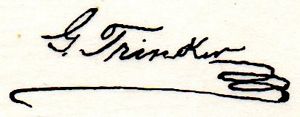 |
Consejero
|
José Zorrilla Tejeda’s father, Jose Zorrilla Trápaga, was born in Santander, Spain, in 1829. He arrived in Oaxaca in 1846 and joined his uncle, Juan Sáenz Trápaga, a textile expert, in a business producing cochineal dye. He made enough money to buy the San Nicolás hacienda in Zimatlán and then, with Trápaga, the San José textile mill in San Agustín Elta, 17 kilometres from the capital. In 1884 he opened the San Agustín factory in La Soledad de Vista HermosaThe Vista Hermosa factory was established in April 1885. The latest machinery was imported from England and transported to Oaxaca by mule train. By 1901 Vista Hermosa had increased its spindles to six thousand and employed four hundred laborers; the factory ran both day and night shifts. with the British businessman Tomás Grandison. Zorrilla became a major player in Oaxaca’s social, political and economic networks and married the heiress Josefa Tejada. He established a second company, José Zorrilla y Compañía with Juan Trápaga and Tomás Grandison and after these two cofounders died brought in two of his sons, José hijo and Federico. With the backing of the Banco Nacional de México José Zorrilla y Compañía financed projects such as the Ferrocarril Mexicano del Sur and the Banco de Oaxaca and was involved in imports and exports. The Zorrillas had a passing interest in the richest gold mine in the state (La Natividad), owned a cereal hacienda in Zimatlán (San Nicolás), two coffee plantations (Cántabro y Santander) and a cornmill (Montañés). José Zorrilla Trápaga died in 1897. The son, José Zorrilla Tejada, was Presidente Municipal in 1904 and served as a federal deputy. In 1902 he was president of the Club Central Unión y Paz which supported Emilio Pimentel’s bid for the governorship and in 1910 was president of the Club Central Reeleccionista, which supported President Díaz. In 1915 he served as Tesorero General to governor José Inés Dávila, when the latter was asserting the state’s sovereignty. For this he was arrested and briefly detained before being released to home detention in July 1916AMOax, Gobierno Preconstitucionalista 1916, Comunicaciones con el alcaide sobre diversos reos. José Zorrilla was Vice President of the bank from August 1902 to October 1902 and President from October 1902 to June 1909. |
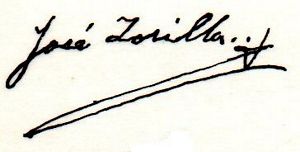 |
|
Jacobo Lucas Grandison, the son of Thomas Grandison, inherited the Xía textile factory from his father. He also owned the coffee finca Esperanza in Pochutla, was a stockholder in the Cía. del Ferrocarril Agrícola y Urbano de Oaxaca, and served as local deputy between 1907 and 1911. In 1902 Grandison organised the Compañia Minera de Etla, S.A.Its consejo de administración was controlled by Grandison, Federico and José Zorrilla Tejada, Francisco Gómez Trápaga, Gildardo Gómez, Guillerrmo Tnnker and Feliciano Hazas. Other shareholders included Juan Antonio del Valle, Luis G. Bellon, Francisco,Enrique and Manuel Zorrilla Tejada, Josefa Tejada viuda de Zorrilla, Luis Bustamante, Juan and José Gómez Trápaga, José Sainz Trápaga Granja, Ignacio Morales y Benítez, Manuel Rivero Collada, Francisco M. Conde, Antonio Quijano y Quijano, Agustín de la Hidalga, Alberto Díaz Ceballos and Miguel Benítez Noriega. Eventually Grandison and the Zorrilla became involved in the oil industry in the state. In October 1905 Grandison organized a company the began drilling for oil around Puerto Angel, Oaxaca(The Mexican Herald, 5 October 1905; The Mexican Herald, 2 November 1905) The Compañia Petrolera de Puerto Ángel, S.A. had 28 shareholders, including Jacobo Lucas Grandison, Constantino Rickards, José, Federico and Enrique Zorrilla Tejada, Maximiliano Reimers, Guillermo Metxueiro, Luis Bustamante, Manuel Rivero Collada, Antonio Quijano y Quijano, Agustín de la Hidalga, Ángel Díaz Rubln y Angel Solana. Its junta de vigilancia was composed of Jacobo L. Grandison, José Zorrilla and Francisco Gómez Trápaga, the manager was Guillermo Trinker and the book-keeper (tenedor de libros) Luis Benitez (El Popular, 8 July 1901). Grandison was President of the bank from August 1902 to October 1902 and Vice-president from October 1902 to June 1909. |
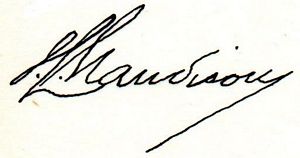 |
|
Francisco Gómez Trápaga, a member of another prominent Oaxaca family, also owned a hacienda in Zimatlán (Santa Gertrudis) and other businesses. Trapaga was vocal propietario from August 1902 through to June 1909. |
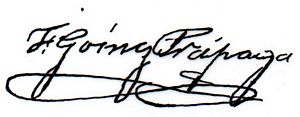 |
Interventor
|
Alejandro Rueda Camacho was appointed Interventor on 19 August 1902, on the recommendation of Emilio PimentelCEHM, Fondo CDLIV Colección José Y. Limantour, 2a, 1902, carpeta 1 legajo 78. Rueda Camacho was Interventor until April 1909 when he left to take up the post of Administrador Principal del Timbre in Colima, because the bank was merging with the Banco Oriental de México and so his post would disappearCEHM, Fondo CDLIV Colección José Y. Limantour, Copiadores. Ministro-III. 10. Libro26. 160. Rueda Camacho owned the Hacienda of Jalapilla, in Elta, Oaxaca, and treated his peons poorly. “It would take long to relate the hardships and sufferings passed under the rigour and bad faith of the owner of the hacienda, as well as that of its foremen and administrators, who despite exploiting our work and our energies, still robbed us and have robbed us of the fruit of our sweat and work. We have sown and worked the lands for the landowner, and we have done it for the minimum wage of 18 centavos a day, apart from each year we are required to have a Guelaguetza, or what is the same, to work for the landowner 12 days without remuneration of any kind. We have never had freedom for anything and advantages of any kind, because we have to pay for the grazing of cattle, we pay for the collecting of firewood and charcoal and we are not even owners of the piece of land we walk on. At one time, those who had the misfortune of getting in a bad situation with the owner, were consigned to the Army and others interned in prison, only for the fact that they once claimed their rights; in the end, a cruel and despotic tyranny was exercised over us, which we have shaken halfway thanks to the revolution initiated by the apostle Madero and continued by the revolutionary, Venustiano Carranza”Legislatura XXXI, Diario de los Debates Núm. 67, 25 March 1925 letter to Senator Luis G. Monzón, 2 March 1925. On 2 March 1925 his tenants wrote to Senator Luis G. Monzón to complain that, since the process of ejidisation began in 1922, Rueda Camacho “has unleashed a real persecution against us, with the aim to disorganize us or make us desist from our purposes”ibid.. At this time Alejandro Rueda Camacho also held the position of special visitor of the Timbre in the state. |
 |
